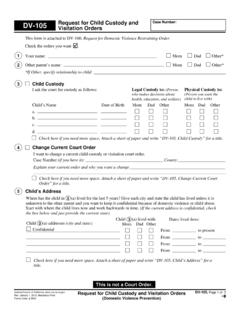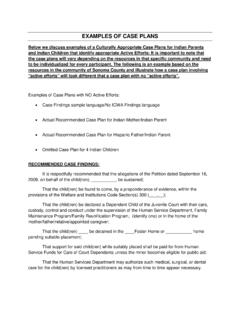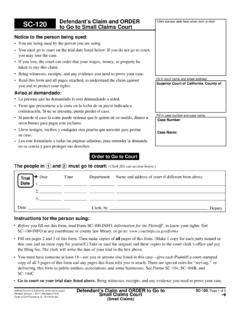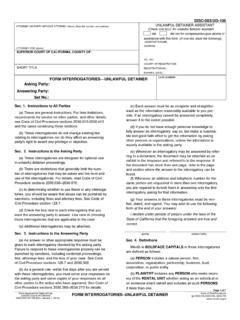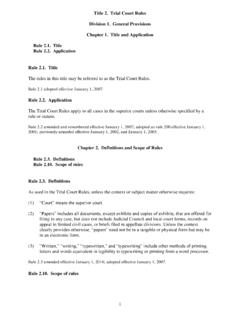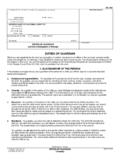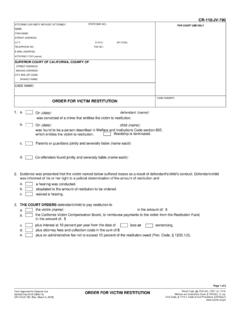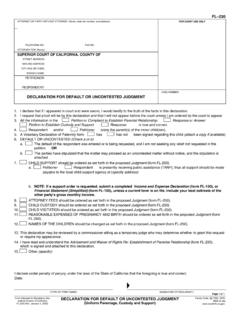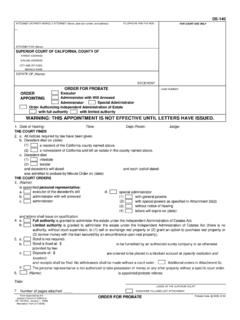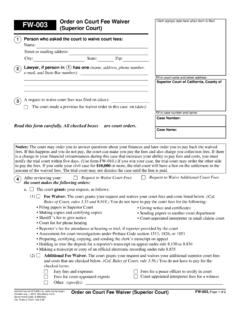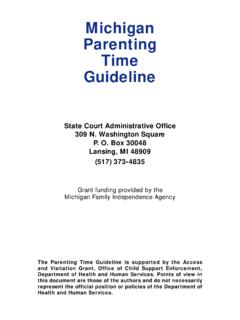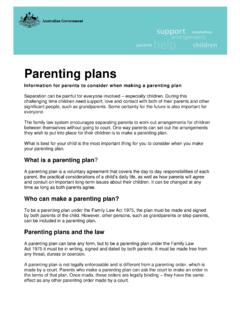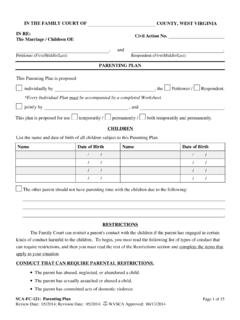Transcription of FL-107-INFO Legal Steps for a Divorce or Legal Separation
1 FL-107-INFO Legal Steps for a Divorce or Legal Separation step 1. Start Your Case The petitioner (the person who files the first Divorce or Legal Separation forms with the court) fills out and files with the court clerk at least a Petition Marriage/Domestic Partnership (form FL-100) and a Summons (form FL-110) and, if there are children of the relationship, a Declaration Under Uniform Child Custody Jurisdiction and Enforcement Act (form FL-105). The forms needed to start your case and information about filing fees and fee waivers are available at Filing Your Case, at . The court clerk will stamp and return copies of the filed forms to the petitioner.
2 step 2. Serve the Forms Someone 18 or older not the petitioner serves the spouse or domestic partner (called the respondent) with all the forms from step 1 plus a blank Response Marriage/Domestic Partnership (form FL-120) and files with the court a proof-of-service form, such as Proof of Service of Summons (form FL-115), telling when and how the respondent was served. (To serve means to give in the proper Legal way. ) For more information, see Serving Your First Set of Court Forms at . The respondent has 30 days to file and serve a Response. So, the petitioner must wait 30 days before starting step 4. step 3.
3 Disclose Financial Information At the same time as step 1 or within 60 days of filing the Petition, the petitioner must fill out and have these documents served on the respondent: Declaration of Disclosure (form FL-140), Income and Expense Declaration (form FL-150), Schedule of Assets and Debts (form FL-142) or Property Declaration (form FL-160), and all tax returns filed by the party in the two years before serving the disclosure documents. These disclosure documents are not filed with the court. If the respondent files a Response, he or she must also complete and serve the same disclosure documents on the petitioner within 60 days of filing the Response.
4 The 60-day time frame for serving the disclosures may be changed by written agreement between the parties or by court order. The petitioner and respondent each file a Declaration Regarding Service (form FL-141) with the court saying disclosures were served. If the respondent does not serve disclosures, the petitioner can still finish the case without them. For more information, see Fill Out and Serve Your Financial Declaration of Disclosure Forms at (click on step 4). step 4. Finish the Divorce or Legal Separation Case in One of Four Ways Respondent does not file a Response (called default ) Respondent files a Response No Response and NO No Response BUT written Response AND written Response and NO.
5 Written agreement: agreement: Petitioner attaches agreement: Either party files agreement: Parties must Petitioner waits 30 days after the signed and notarized Appearance, Stipulations, and go to trial to have a judge step 2 is complete and agreement to the proposed Waivers (form FL-130) and the resolve the issues. See prepares a proposed Judgment Judgment (form FL-180), proposed Judgment with Contested Case at (form FL-180), together with together with all other needed written agreement attached and all other needed forms. See forms. See Default Case with other needed forms. See True Default Case at courts.
6 Written Agreement at courts. Uncontested Case at courts. IMPORTANT NOTICES.. The earliest you can be divorced is six months and one day from one of these three dates (whichever occurs first): (1) the date Respondent was served with the Summons (form FL-110) and Petition (form FL-100), (2) the date the Response (form FL-120) was filed, or (3) the date Appearance, Stipulations, and Waivers (form FL-130) was filed. Legal Separation has no waiting period. You are NOT divorced or legally separated until the court enters a Judgment in your case. If you need court orders for child support, custody, parenting time ( visitation ), spousal or partner support, restraining orders, or other issues, file a Request for Order (form FL-300) asking for temporary orders.
7 See Request for Order Information at for more information. Annulments: See for information about annulments. You must keep the court and the other party informed of any change in your mailing address or other contact information. File and serve a Notice of Change of Address or Other Contact Information (form MC-040) on the other party or his or her attorney to let them know about the change in your contact information. Judicial Council of California, FL-107-INFO , Page 1 of 2. Revise January 1, 2015, Optional Form Legal Steps for a Divorce or Legal Separation Cal. Rules of Court, rule FL-107-INFO Legal Steps for a Divorce or Legal Separation Do you have a registered domestic partnership?
8 The process for a Divorce or Legal Separation of a domestic partnership is the same as on page 1. For information about ending your domestic partnership in the superior court, see gov/filing. To find out if you are eligible to end your domestic partnership through the Secretary of State, see gov/summdissodp. Note: There may be differences in federal taxes and other issues for domestic partnerships. Seek advice from an attorney experienced in domestic partner law. What if you want a Legal Separation ? The process on page 1 is the same, except you will NOT get a Judgment for Legal Separation unless both parties agree to a Legal Separation OR if respondent has not filed a Response.
9 If both parties agree to be legally separated but do not agree on other issues, the parties must go to trial to have a judge resolve those issues. You are NOT legally separated until you receive a Judgment signed by the court. For more information, see Legal Separation at AFTER the court enters a judgment for Legal Separation , if you decide you want a Divorce , you must start a new case to request a Divorce and pay another filing fee. Getting help to resolve Divorce or Legal Separation cases You may prefer to resolve some or all of the issues in your Divorce or Legal Separation case without having the court decide for you.
10 You and your spouse or domestic partner can put your agreement in writing and file it in your case. But your agreement must follow all Legal requirements. Court Services Where can I get help? . Family Law Facilitators and Self-Help Centers This information sheet gives you only basic information on help with court forms and instructions. They can the Divorce or Legal Separation and is not Legal advice. If you provide samples of agreements and other want Legal advice, ask a lawyer for help. You may also: information and, in some cases, help with mediation.. Contact the family law facilitator or self-help center in Family Court Services.
